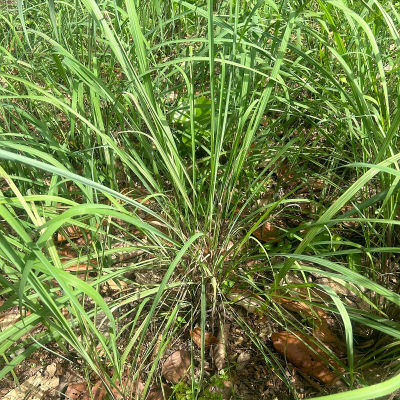Distribution and habitat: Citronella grass has now been widely distributed throughout tropics comprising Sri Lanka, Java, Central America, Guatemala, Taiwan, Brazil, East Africa, Congo, Malagasy Republic, Seychelles, India and West Indies. In India, it is cultivated in States of Assam, West Bengal, Uttar Pradesh, Maharashtra, Karnataka, Tamil Nadu, Gujarat, Arunachal Pradesh, Manipur, Mizoram, Meghalaya, Nagaland and Tripura. Production of Java citronella exceeds other essential oils.
Botany: It is a tufted aromatic perennial herb with fibrous roots. Plants are over 2 m in height. Clumps are stout, erect, terete, leafy and glabrous at nodes.
- Leaf : Blades linear, with long acuminate tip and serrate margins. Ligules are scarious.
- Inflorescence : Very large compound panicle. Racemes 20 mm long, one sessile and other pedicelled with two lower spikelets, homogeneous, male or neuter, remaining pairs in both racemes heterogeneous. Ovary superior with one carpel, unilocular. Stigma bifid, lateral and leathery. Ovule single and erect.
Chemical constituents: Java oil serves as a starting material for extraction of geraniol and citronellal which can be converted into aroma chemicals such as citronellol, hydroxy citronellol, synthetic menthol and esters of geraniol.
Properties: These find extensive use in soap, perfumery, cosmetic and flavouring industries throughout world. Soaps, soap flakes, detergents, household cleansers, insecticides and other technical products are often perfumed exclusively with this oil. Citronellol is used in many perfumery blends of soap and cosmetic industries when rosaceous notes are required. Hydroxy citronellol is a key ingredient in compounding and in floralizing perfume materials. Citronellol esters like formate and acetate are used in a wide range of fragrances. Oil is also used in manufacture of deodorants, mosquito repellent creams and allied products. Oil of Ceylon citronella is employed chiefly for perfuming low priced technical preparations such as detergents, sprays, polishes and insect repellents. Spent grass can be used as a source of raw material for cellulose pulp and paper production by using sulphate, sulphite and cold caustic soda.
Agro technology:
Soil and climate: It requires abundant moisture and sunshine for good growth. Rainfall of 100-150 cm influences growth of plant, yield and quality of oil favourably. However, its distribution is more important than total rainfall. In areas where rainfall is less, plant can be grown with supplemental irrigation. Though, the plant grows under a wide range of soil conditions, sandy loam uplands with abundant organic matter is the most suitable. Heavy clay soils and sandy soils do not support good growth. Crop is very sensitive to water‑logging. It grows under a wide range of pH (5-8) though 6-7 is ideal.
Fertilizers and Manures: FYM is applied (10 tonnes/ ha) before planting. A fertilizer dose of 200 kg N, 80 kg P2O5 and 40‑80 kg K2O /ha/ annum is recommended for optimum growth and yield. Better results are obtained by applying N in 4 equal split doses at an interval of about 3 months. P and K are applied fully as basal.
Irrigation: Irrigation is required within 24 hours of planting, if there is no rain. Supplemental irrigation is not required in areas with 2000‑2500 mm rainfall, well distributed over the year. However, in drier months irrigation may be provided for better yield. Depending on weather and soil conditions, 8‑10 irrigation is required in dry areas during rain free period.
Harvesting: Crop is ready for first harvest after about 9 months of planting and subsequently at an interval of 3 months. Harvesting is done by sickle above first node at 20‑45 cm above ground. Generally leaf blades are cut and sheath are left out. Flowering should be discouraged as it causes aging and reduces life span of plantation. Harvesting can be done 4 times a year. Generally, Java crop once planted yields profitable returns for 4‑5 years and needs replanting only afterwards.
Pests & Diseases:
- Adults of termite species, Microtermus obesi (Isoptera: Termitidae) damage roots of plants throughout the year and plants get dried.
- Grubs of white grub, Holotrichia consanguinea (Coleoptera: Melolonthidae) feed on roots.
- White larvae of shoot borer, Chilo infuscatellus (Lepidoptera: Pyralidae) with fine longitudinal stripes bore into stems of young plants causing dead heart
Processing: Harvested grass is wilted in shade for a short time and steam distilled within 24 hours. Oil yield varies with season, soil fertility and distillation efficiency. On an average, 0.8‑1.2% of oil is recovered from grass and oil yield is about 100 kg/ha during first year and 150 kg/ha during subsequent years. Yields of 200‑250 kg/ha/yr can be obtained under favourable conditions with good management.



